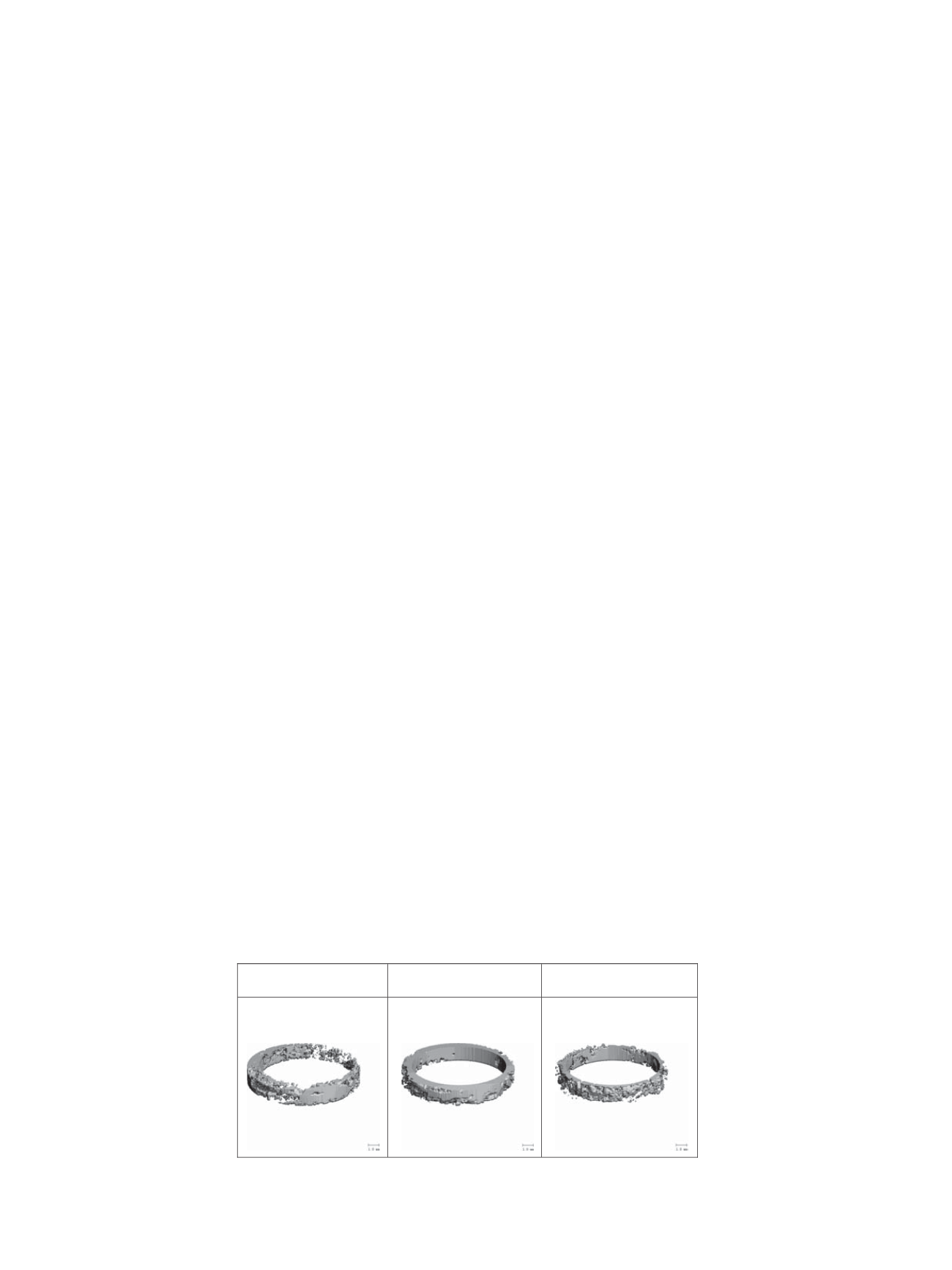

Surgical procedure for drill hole defects
After general anaesthesia, the lumbar spine, iliac crest and left distal
femur regionwere shaved, disinfected and subsequently was draped in
sterile manner. An incision to the skinwas made at the midline laterally
to the spine where the spinous process, transverse process, and the
pedicles of the L2-L5 were located. Further incisions were made to
allow parapedicular access of the vertebral body to create a bone defect
with 5 mm diameter using a saline-cooled trephine (DBCS; Biomet
Deutschland, Berlin, Germany). The defects were either filled with the
respective biomaterial or left empty according to the study protocol.
For the distal femur and the iliac crests, skin incision and dissection of
the subcutaneous tissue followed by incision of the fascia was
performed and cylindrical defects with a diameter of 8 mm with the
DBCS (DBCS1; Biomet Deutschland, Berlin, Germany) were created.
Then defects were treated according to the study protocol as well. The
wounds were closed with multilayer sutures and draped in sterile
manner. Postoperatively, infrared light was used to prevent hypother-
mia. The animals were allowed full weight bearing and free access to
water and goat diet.
Harvesting of specimens
The goats were sacrificed at the end-point of six weeks (42 days)
post-bone defect surgery. Euthanasia was carried out by intravenous
overdose pentobarbital (Dorminal 20%, Alfasan, Kuipersweg 9,
Woerden, Holland) at 50 mg/kg of body weight. Each of the defective
sites were carefully removed including the lumber vertebral bodies
from L3 to L5, left and right illac crests, and left femoral condyle.
Samples were immediately fixed in 9% buffered formalin for five days
and preserved in 70% ethanol thereafter.
High-resolution peripheral quantitative computed tomography
(HR-pQCT) of bone specimens
Each samplewas subjected to HR-pQCT (XtremeCT, Scanco Medical,
Brüttisellen, Switzerland). Scanningwas performed covering the entire
bone defect at the defective site using 59400 V and 900 µA, creating
reconstructed two-dimension images at resolution of 41 micrometers.
The region of interested was defined at the host bone-defect/
biomaterial interface [16], and selected as a ring shaped hollow
cylinder (Figure 1) with 1 mm offset thickness and 2 mm in depth,
across all defective sites with various treatments methods. Three
dimensional reconstructions and the histomorphometric parameters
were evaluated by the standard algorithms in the built-in software
with segmentation threshold set at 1.2/2/124. Bone volume (BV)
was the volume of pixels with density higher than or equal to the
threshold, and that tissue volume (TV) was the volume of the region of
interest. The mean of the following parameters: Apparent bone
mineral density (BMD), BV to TV ratio (BV/TV), Trabecular Number
(Tb.N), Trabecular thickness
(Tb.Th), trabecular spacing
(Tb.Sp), and
Connectivity Density (Conn.D) were compared between groups and
difference between groups were tested using Kruskal-Wallis test with
confidence intervals at 95%.
Histology and histomorphometry
Both quantitative and qualitative histology was performed for
determination of new bone formation and local tissue reactions of the
different implants, respectively. For histological examinations in light
microscopy, decalcified and undecalcified samples were used that were
brought into 4% paraformaldehyde solution after explantation and
Micro-CT analysis. Samples for decalcification were incubated in 10%
EDTA (Carl Roth GmbH, Karlsruhe, Germany), embedded in paraffin
and cut into 5 µm sections with a Leica RM2155 microtome (Leica,
Wetzlar, Germany). Undecalcified samples were embedded in methyl
methacrylate and sawed into 20 µm sections using the method of
Donath and Breuner [19]. Subsequently, the sections were stained with
toluidine blue and hematoxyline-eosin.
Histomorphometry was carried out on the hematoxyline-eosin
sections. New bone formation was determined using a light micro-
scope (Axiophot-2, Zeiss, Jena, Germany) and digital image software
(Media Cybernetics; Silver Spring MD, USA) for quantitative assess-
ment. Two different region of interest (ROI) were defined:
1.
Initial defect region
2.
Host bone-defect/biomaterial interface region with a distance of
1 mm to the initially created defect. This region corresponded to
the ROI analysed by HR-pQCT (see section 2.8).
The area of newly formed bone was then divided by the respective
ROI area, giving the percentage of new bone formation in relation to the
entire area.
Statistical analysis was done using one way variance analysis with
SPSS for Windows (Version 16), allowing direct comparison between
the different implants. As normal distribution could not be assumed,
Kruskal-Wallis-H-Test and subsequent Mann-Whitney-U-Test was
performed. P-values < 0.05 (marked by *) were considered to be
statistically significant and p-values < 0.01 (marked by **) were defined
as statistically high significant. This analysis was done for all defects of
each treatment group including spinal, iliac crest and femur defects as
well as separately for spinal defects and separately for iliac crest
defects. Due to the limited number of
n
= 2 for distal femur defects per
treatment group this site specific comparison was not possible.
For further histological biocompatibility assessment, the sections
were studied qualitatively using detailed histology with the focus on
the appearance of newly formed bone, osteoclast-like cells, fragmen-
tation of implants, and integrity of bone marrow.
EMPTY
OSTIM
OSTIM + Col-1
Fig. 1.
3D reconstructed images of the region of interest for high-resolution peripheral quantitative computed tomography (HR-pQCT) of the defective bone sites representing a
ring shaped hollow cylinder with 1 mm offset thickness and 2 mm in depth at the host bone-defect/biomaterial interface.
V. Alt et al. / Injury, Int. J. Care Injured 47S2 (2016) S58
–
S65
S60


















